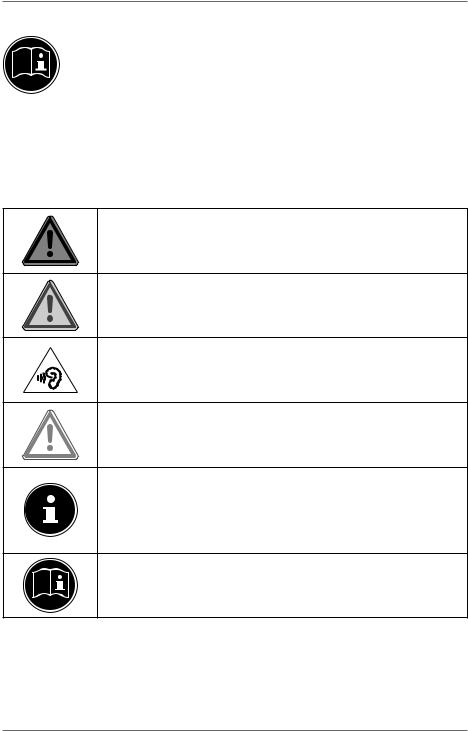Medion AKOYA Instruction manual

Instruction Manual
43,9 cm / 17,3“ Notebook
MEDION® AKOYA®

Table of Content
1. |
About these Instructions............................................................................. |
4 |
|
|
1.1. |
Symbols and Key words used in these Instructions................................... |
4 |
|
1.2. |
Proper Use ................................................................................................................. |
5 |
|
1.3. |
Declaration of Conformity................................................................................... |
5 |
|
1.4. |
Information on trademarks................................................................................. |
6 |
2. |
Safety Instructions....................................................................................... |
6 |
|
2.1.Dangers for children and people with reduced ability to operate
|
|
electronics ................................................................................................................. |
6 |
|
2.2. |
Operational Safety .................................................................................................. |
6 |
|
2.3. |
Never carry out repairs yourself ....................................................................... |
9 |
|
2.4. |
Data backup .............................................................................................................. |
9 |
|
2.5. |
Setup Location ......................................................................................................... |
9 |
|
2.6. |
Environmental Requirements .......................................................................... |
10 |
|
2.7. |
Ergonomics ............................................................................................................. |
11 |
|
2.8. |
Connecting .............................................................................................................. |
12 |
|
2.9. |
Cabling ...................................................................................................................... |
13 |
|
2.10. |
Information about the Touchpad .................................................................... |
14 |
|
2.11. |
Notes on the Battery ............................................................................................ |
15 |
|
2.12. |
Protecting the Display ........................................................................................ |
16 |
3. |
Included with your Notebook................................................................... |
17 |
|
4. |
Views |
........................................................................................................... |
18 |
|
4.1. |
Open Notebook ..................................................................................................... |
18 |
|
4.2. .................................................................................................................... |
Left Side |
19 |
|
4.3. ................................................................................................................. |
Right Side |
19 |
5. |
Operating .......................................................................and Status LEDs |
20 |
|
6. |
Preparation ......................................................................for Starting-Up |
21 |
|
7. |
Power .............................................................................................Supply |
22 |
|
|
7.1. ......................................................................................................... |
On/Off Switch |
22 |
|
7.2. ........................................................................................................... |
Mains Power |
23 |
|
7.3. .......................................................................................................... |
Battery Mode |
24 |
|
7.4. ........................................................... |
Power Management (Power Options) |
26 |
8. |
Display ........................................................................................................ |
27 |
|
|
8.1. ................................................................... |
Opening and Closing the Display |
27 |
|
8.2. ..................................................................................... |
Touch Screen (optional) |
27 |
|
8.3. ..................................................................... |
Connecting an External Monitor |
29 |
9. |
Data Input................................................................................................... |
30 |
|
|
9.1. .................................................................................................................. |
Keyboard |
30 |
|
9.2. ................................................................................................................. |
Touchpad |
31 |
10. |
Optical .............................................................................Drive (optional) |
32 |
|
|
10.1. ...................................................................................................... |
Inserting a Disc |
32 |
2

|
10.2. |
Playing/Reading Discs......................................................................................... |
33 |
|
10.3. Regional Playback Information for DVDs..................................................... |
33 |
|
|
10.4. Issues Relevant to the Burner........................................................................... |
34 |
|
11. |
Sound System............................................................................................. |
34 |
|
|
11.1. |
External Audio Connections ............................................................................. |
34 |
12. |
Network Operation.................................................................................... |
35 |
|
|
12.1. |
Network Connection ........................................................................................... |
35 |
|
12.2. |
Wi-Fi (Wireless Network) .................................................................................... |
35 |
|
12.3. |
Bluetooth................................................................................................................. |
36 |
|
12.4. |
Flight Mode............................................................................................................. |
36 |
13. |
Multimedia Card Reader ........................................................................... |
37 |
|
|
13.1. Inserting a Memory Card ................................................................................... |
37 |
|
|
13.2. |
Removing Memory Cards .................................................................................. |
37 |
14. |
USB Port ..................................................................................................... |
37 |
|
15. |
Hard drive................................................................................................... |
38 |
|
16. |
Securing Your Notebook ........................................................................... |
39 |
|
|
16.1. |
Password Setting (Power-on) ........................................................................... |
39 |
|
16.2. |
Kensington Security Lock .................................................................................. |
39 |
17. |
Resetting the notebook to its Factory Settings ...................................... |
40 |
|
|
17.1. System recovery with PowerRecover (optional)........................................ |
40 |
|
|
17.2. System restore with Windows Recovery options ...................................... |
41 |
|
18. |
UEFI Firmware Configuration ................................................................... |
42 |
|
|
18.1. Executing the UEFI Firmware Configuration............................................... |
42 |
|
19. |
FAQ – Frequently Asked Questions .......................................................... |
43 |
|
20. |
Customer Service ....................................................................................... |
43 |
|
|
20.1. What To Do in Case of Hardware Problems ................................................ |
43 |
|
|
20.2. |
Find the Cause ...................................................................................................... |
43 |
|
20.3. Do You Need More Help?................................................................................... |
45 |
|
|
20.4. |
Driver Support ....................................................................................................... |
45 |
|
20.5. |
Transport.................................................................................................................. |
45 |
|
20.6. |
Maintenance........................................................................................................... |
46 |
21. |
Upgrading/Modifying and Repair ............................................................ |
46 |
|
|
21.1. |
Notes for Service Technicians........................................................................... |
47 |
22. |
Recycling and Disposal.............................................................................. |
47 |
|
23. |
European EN 9241-307 Class II Standard................................................. |
48 |
|
|
23.1. |
FCC Compliance Statement .............................................................................. |
49 |
24. |
Legal Notice................................................................................................ |
50 |
|
25. |
Index |
........................................................................................................... |
51 |
3

1. About these Instructions
Before using the device for the first time, please read these operating instructions carefully, paying special attention to the safety notices. This device should only be used as designated and as described in these instructions.
Please keep these instructions in a safe place for future reference. Always include these instructions if passing the device on.
1.1.Symbols and Key words used in these Instructions
DANGER!
Warning of immediate risk of fatal injury!
WARNING!
Warning: possible mortal danger and/or serious irreversible injuries!
WARNING!
Warning: danger due to excessive volume!
CAUTION!
Warning: possible light or moderate injuries!
PLEASE NOTE!
Please follow the guidelines to avoid property damage.
Additional information on using the device.
PLEASE NOTE!
Please follow the guidelines in the operating instructions.
4

1.2. Proper Use
This device is designed for the use, management and editing of electronic documents and multimedia content, as well as for digital communication. The device is intended for private use only and not for industrial/commercial use. Please note that we shall not be liable in cases of improper use:
•Do not modify the device without our consent and do not use any auxiliary equipment which we have not approved or supplied.
•Use only spare parts and accessories which we have supplied or approved.
•Follow all the instructions in this instruction manual, especially the safety information. Any other use is deemed improper and can cause personal injury or damage to the product.
•Do not use the device in areas where there is a risk of explosion. This includes e.g. tank farms, fuel storage depots or areas in which solvents are processed. It is also not permitted to use this device in those areas where the air is polluted with fine particles (e.g. flour dust or sawdust).
•Do not use the device in extreme environmental conditions.
1.3. Declaration of Conformity
This product is supplied with the following wireless features:
•Wireless LAN
•Bluetooth
Medion AG hereby declares that this product conforms to the following European requirements:
•R&TTE Directive 1999/5/EC
•Ecodesign Directive 2009/125/EC
•RoHS Directive 2011/65/EU
Should your device work with a network connection in the 5 GHz frequency range of the inbuilt wireless LAN solution, then it can only be used inside buildings in all EU countries.*
Full declarations of conformity are available at www.medion.com/conformity.
* In order to meet this requirement, you should not use channels 34-64 at your wireless LAN access point.
5

1.4. Information on trademarks
Windows® is a registered trademark of Microsoft®. Intel, the Intel Logo, Intel Inside, Intel Core, notebook, and Core Inside are trademarks of Intel Corporation in the U.S. and/or other countries.

 ® , the HDMI logo and the name High-Definition Multimedia Interface are registered trademarks of HDMI Licensing LLC.
® , the HDMI logo and the name High-Definition Multimedia Interface are registered trademarks of HDMI Licensing LLC.
Other trademarks are the property of their respective owners.
2. Safety Instructions
2.1.Dangers for children and people with reduced ability to operate electronics
•This device is not intended for use by people (including children) with reduced physical, sensory or mental abilities or for those without experience and/or knowledge, unless they are supervised by a person responsible for their safety or they have been instructed in its use.
•Children should be supervised to ensure that they do not play with the device. Children should not be allowed to use this device without supervision.
•Keep the device and its accessories out of reach of children.
DANGER!
Risk of suffocation!
Packaging film can be swallowed or used improperly. Therefore, there is a risk of suffocation!
Keep packaging material such as plastic film or plastic bags away from children.
2.2.Operational Safety
Please read this section carefully and follow all instructions given. The instructions will help you to operate the notebook reliably and increase its service life.
•Never open the housing of the notebook, battery or mains adapter! This could result in an electric shock or even ignite a fire which will damage your notebook.
6

•Optical drive (CD/CDRW/DVD) constitute class 1 laser equipment providing these devices are contained in a sealed notebook housing. Do not remove the drive cover as invisible laser radiation may escape.
•Do not insert anything into the notebook through the slots and openings. This could result in an electric shock or even ignite a fire which will damage your notebook.
•The slots and openings on the notebook are for ventilation purposes. Do not cover these openings as this could cause the device to overheat.
•The notebook is not intended for use by companies in the heavy industry sector.
•To avoid damage from lightning strikes, do not operate the notebook during thunderstorms.
•Do not place any objects on top of the notebook and do not exert pressure on the display. Otherwise, there is a risk that the display may break.
•If the screen breaks, there is a danger of injury. If this happens, pick up the shattered pieces wearing protective gloves and send them to your service centre for professional disposal. Finally, wash your hands with soap, as the pieces may have been contaminated with chemicals.
•Do not fold the display back by an angle of more than 120°. Exceeding this value may damage the housing or the
notebook. Always hold the display firmly by the middle when folding it back, adjusting the position and closing it. Failure to do so may damage the display. Never use force to open the display.
•In order to avoid any damage to the device, ensure that the plug contacts do not come into contact with water under any circumstances. If this should nevertheless occur, it is imperative that the plug contacts are rubbed dry before the device is used again.
7

•To avoid damaging the screen, do not touch it with fingers or sharp objects.
•Never lift the notebook up by the display as this could break the hinges.
•Over time, dust can collect inside the notebook which then blocks the vents. This can lead to an increase in the fan speed and, therefore, also increase the operating volume of your notebook. It can also lead to overheating and malfunctions. Therefore, have the interior of the notebook cleaned by your service department or a specialist at regular intervals.
•Should the below occur, switch the notebook off immediately/ do not switch the notebook on, disconnect the mains plug and contact customer services if
−the mains adapter or the attached power cable or plug is burnt or damaged. Replace faulty mains cables/mains adaptors only with original parts. These parts should not be repaired under any circumstances.
−the notebook housing is damaged or liquid has penetrated into the device. Have the notebook inspected by customer services. Otherwise, it may not be possible to operate the notebook safely. There may be a risk of electric shock and/ or harmful laser radiation!
If the notebook gets wet,
•do not switch on.
•disconnect the power cable.
•not switch on until the notebook has dried off completely.
8

2.3. Never carry out repairs yourself
WARNING!
Risk of electric shock!
If there is a fault, contact the Service Centre or other suitable specialist workshop, in order to avoid a hazard.
Never try to open or repair the device yourself.
2.4.Data backup
PLEASE NOTE! Loss of data!
Back up your data to external storage media before each update. We do not accept any liability for claims for compensation arising from loss of data or any consequential loss or damage.
2.5. Setup Location
•Keep your notebook and all connected devices away from moisture and avoid dust, heat and direct sunlight.
Non-compliance with these instructions can lead to faults or damage to the notebook.
•Do not use the notebook outdoors because external elements, such as rain, snow, etc., could damage it.
•Set up and operate all components on a stable, level and vibration-free surface to prevent the notebook from falling down.
•Do not operate the notebook or power adaptor for long periods on your lap or any other body part as the heat dissipation on the underside can result in uncomfortable overheating.
•This device is not suitable for use with VDU workstations.
9

2.6. Environmental Requirements
•The notebook is most reliably operated at an ambient temperature between 5 °C (+41 °F) and 30 °C (+86 °F) and at a relative humidity between 20% and 80% (without condensation).
•When powered off, the notebook can be stored at temperatures between 0 °C and 60 °C (+32 °F and 140 °F).
•During a thunderstorm, disconnect the mains plug. For extra safety, we recommend using an overvoltage protection device to prevent the notebook from sustaining damage as a result of power surges or lightning strikes.
•After transporting the notebook, wait until the device has reached room temperature before switching it on. Large changes in temperature or fluctuations in humidity can cause moisture build up within the notebook due to condensation. This can cause an electrical short circuit.
•Keep the original packaging in the event the device needs to be sent in.
10

2.7. Ergonomics
PLEASE NOTE!
Avoid dazzle, reflections and strong bright-dark contrast in order to protect your eyes.
The notebook should never be placed next to a window because this is the brightest part of the room in daylight. This brightness can make it more difficult for the eyes to adjust to the darker display. The notebook should always be positioned so that the direction of vision is parallel to the window front.
Setting up the notebook with your back to the window is incorrect as reflections from the bright window on the screen will then be unavoidable. A position looking onto the window is also incorrect as the contrast between the dark screen and the bright daylight can cause problems for the eyes to adjust and result in problems.
The parallel line of vision should also be maintained in relation to artificial lighting equipment.
In other words, the same criteria and principles apply where the workspace is illuminated with artificial light. Where space restrictions make it impossible to set up the screen as described, then correct positioning (rotating, tilting) of the notebook/ screen can prevent dazzling, reflections and excessive brightdark contrast, etc. In many cases, an improvement can also
be achieved by using slats or vertical blinds on the windows, partition walls or by changing the artificial lighting equipment.
11

2.8. Connecting
Follow the instructions below to connect your notebook correctly and safely:
2.8.1. Power Supply
DANGER!
Risk of electrical shock!
There are live components inside this mains adapter. In the event of an unintentional short circuit of this mains adapter, there is a risk of electrical shock or fire!
Do not open the housing of the mains adapter.
•The socket outlet must be close to the notebook and easily accessible.
•To disconnect the power supply from your notebook (via the mains adaptor), pull the mains plug from the power outlet.
•Plug the notebook’s mains adapter into AC 100–240 V~,
50 - 60 Hz earthed sockets only. If you are not sure about the power supply at the set-up location, please ask your power supplier.
•Only use this notebook and accompanying mains adapter with each other.
•For extra safety, we recommend using an overvoltage protection device to prevent your notebook from sustaining damage as a result of power surges or lightning strikes.
PLEASE NOTE!
Only use this notebook and accompanying mains adapter with each other.
12

WARNING! Impairment to hearing!
Listening through earphones or headphones at excessive volume levels, as well as changes to the basic settings of the equaliser, drivers, software or operating system generates excessive acoustic pressure and can lead to loss of hearing.
Before pressing play, set the volume to the lowest setting.
Start playback and increase the volume to a comfortable level.
2.9.Cabling
•Position the cables so that they cannot be stepped on or might cause a risk for tripping.
•To avoid damaging the cables, do not place any objects on them.
•Do not connect peripheral devices – such as keyboards, mouse and monitor, etc. – when the notebook is switched on to avoid damage to the notebook or the devices. Some devices may also be connected while the computer is running. This is generally the case for devices with a USB connection. In all cases, observe the relevant operating instructions.
•Maintain a distance of at least one metre from sources of high-frequency and magnetic interference (TV sets,
loudspeakers, mobile phones, DECT telephones, etc.) in order to avoid malfunctions and data loss.
•Please note that only shielded cables that are shorter than 3 metres may be connected to the external interfaces of this
notebook. Please only use double-shielded cables for printer cable connections.
13

•Do not exchange the supplied cable for another one. Use only the supplied cable as this cable has been extensively tested in our laboratory.
•In addition, when connecting your peripherals only use the connecting cables supplied with those devices.
•Ensure that all connection cables are connected to their corresponding peripheral device to avoid any interference radiation. Disconnect any cables that are not required.
•The only devices which may be connected to the notebook are those that meet the requirements set out in the EN60950 standard “Information Technology Equipment – Safety” or devices that meet the EN60065 standard “Audio, video and similar electronic apparatus – Safety requirements”.
2.10. Information about the Touchpad
•The touchpad is operated with the thumb or another finger and reacts to the energy given out by the skin. Do not use pens or other objects as these can damage your touchpad.
•Dust or grease on the touchpad can affect its sensitivity. Remove the dust or grease from the surface of the touch pad with a soft, dry and lint-free cloth.
14

2.11. Notes on the Battery
WARNING!
Risk of explosion!
There is a risk of explosion if the battery is replaced incorrectly.
Do not heat up the battery to a temperature greater than the maximum ambient temperature stated.
Never open the battery.
Do not throw the battery into an open fire.
Do not short-circuit the battery.
Only replace with the same type of battery or with a similar type recommended by the manufacturer.
Dispose of used batteries in accordance with the information provided by the manufacturer
To extend your battery’s performance and lifespan and ensure safe operation, you should also observe the guidelines below:
•Avoid dirt and contact with electrically conductive materials or chemical substances and cleaning agents.
•Use only the supplied mains adaptor to charge the battery. Make sure (via the notebook display or acoustic signal) that the battery is fully discharged before charging it again.
•Always charge the battery until the battery charging light goes out. Please also observe the information in “Charging the battery” to assess the charge status of your battery.
•Do not remove the battery while the notebook is switched on or data may be lost.
•Take care when storing the battery and when using the notebook that the contacts on the battery and the notebook are not soiled or damaged. This could cause malfunctions.
•Ensure the notebook is switched off before replacing the battery.
15

•If the battery is built-in it cannot be readily replaced by the user themselves. In this case the battery must be replaced by a service technician.
2.12. Protecting the Display
The display is the most sensitive component part of the notebook as it consists of thin glass. It can break if subjected to too much stress.
•Do not scratch the cover of the notebook, because it will not be possible to remove any scratches.
•Avoid contact between the display and hard objects (e.g. buttons, wristwatch).
•Do not place any objects on the display.
•Do not allow any objects to drop onto the display.
•Do not pour any fluids into the notebook, as this could damage it.
•Do not scratch the display with your fingernails or hard objects.
•Do not clean the display with chemical cleaning products.
•Clean the display with a soft, dry and lint-free cloth.
PLEASE NOTE!
The surfaces of the device are covered in protective film to prevent scratching during production and transport. Remove the film once the device has been set up properly and before you use it.
16
